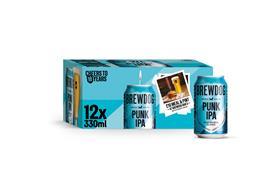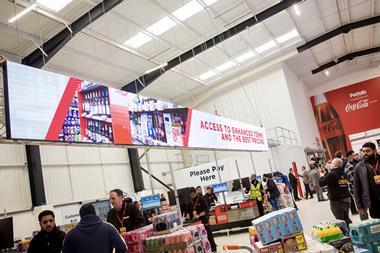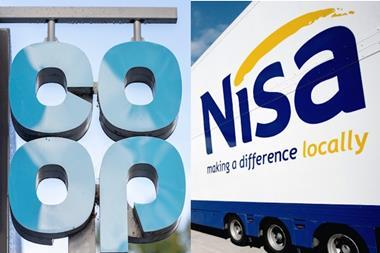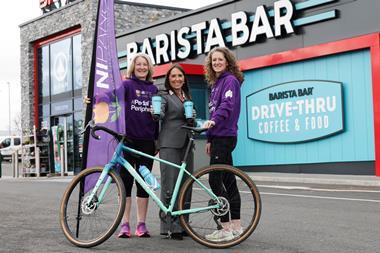Clear ingredients labelling could become as important as the price tag thanks to c-store shoppers’ growing desire to know what their food does and doesn’t contain
Food to go and healthy eating are among the trends retailers need to be following in 2017, but success in these areas could be down to much more than ensuring you’ve got the right products in your store. Today’s shoppers want reassurance over what their food contains and where it comes from, making labelling and POS two vital ingredients.
Simon Biddle, of Biddle’s Simply Fresh in Redditch, has noticed that the healthy eating trend has meant his shoppers are looking more closely at what’s in the food they eat. “I think people are tending towards more natural products rather than products with a long list of ingredients they don’t recognise. People have definitely become more aware of all the added sugars and salts that manufacturers can add to products and so are being more mindful of this when looking at products.”
To make life tougher for retailers, getting into the food-to-go missions means they have to compete with well-established coffee shops whose big budgets and corporate organisation allow them to provide a full breakdown of nutritional statistics in their products.
This is putting pressure on retailers to provide more information on their own-label food and drink, from homemade salads to sarnies and ready meals.
Donna Mullan, co-owner of Mullan’s Spar in Armagh, says her health-conscious shoppers are interested in the calorie count of foods. “A while ago we put the calorie count for our different types of coffee onto the chalk board and noticed straight away that we started selling much less cappuccino, at 102 calories, and much more black Americano, at 3 calories. We realised how important this information is and how health conscious our shoppers must be.”
It’s for this reason that Donna has opted to bring in the assistance of a health specialist to put the calorie count on all the meals made in store. Donna believes this will be greatly appreciated by her weight-watching patrons and will bring her in line with the top coffee shops.
“So many shoppers are on Slimming World and Weight Watchers diets these days and they have to keep count of all the points and calories in their food, so this just makes it easier for them to buy our products and know where they stand. I had no idea how much work it would be to get the calorie count for every product, though, plus to then train all the staff to ensure the quantity of food in each pack stays the same.”
Calories are just one of several concerns that consumers have when it comes to their grab-and-go buys. Diane Pearse, senior supervisor at Spar Bentley in Walsall, says the store’s extensive allergens board is well utilised by shoppers as all the store’s sandwiches are made in house.
“The allergens board up on the wall, near the deli, is very useful. Everything we sell in the deli is up there so they can easily look it up and check for allergens. Customers seem to find it very valuable as we have people asking for allergen information fairly often.”
Providing allergen information is not only helpful to those looking to avoid certain foods, it’s the law. Any product containing an allergen must clearly state so on the label, as well as listing it in the ingredients. Ingredients which are officially considered to be allergens are: celery, cereals containing gluten (including wheat, rye, barley and oats), crustaceans, eggs, fish, lupin, milk, molluscs (including squid, mussels, cockles, whelks and snails), mustard, nuts, peanuts, sesame seeds, soya beans, sulphur dioxide or sulphites at levels above 10mg per kilogram or per litre.
Clear labelling is only likely to take on greater importance in the future as the number of people looking to avoid certain ingredients grows due to lifestyle choices rather than medical reasons. HIM Research & Consultancy has found that 30% of 16- to 34-year-olds now say that they have a food intolerance, with half of these cases self-diagnosed. The number of consumers stating they suffer from food intolerance reduces by age group with 15% of 35- to 45- year-olds and 8% of 55+.
Justin Taylor, of Spar Winford in Somerset, points out that the importance of nutritional values in food is likely to vary from one shopper base to another. “We predominantly sell to white van men who are mostly interested in getting something that’s going to fill them up, so the levels of salt and sugar and such-like aren’t something they’ve shown interest in,” he says.
For the many hand-made baguettes he sells in his store Justin uses labels provided by Cuisine de France. He says these cover the ingredients, price, barcode, use-by date and allergens.
But if it is the case that your shoppers want to know more about what’s in their lunch, it doesn’t have to involve anything more complicated than a sticker or two. Darren Given, manager of Classic Service Station in Omagh, says that stickers are a great way to clearly mark which products can be consumed by different customers.
“On our own labels we have all the ingredients and allergens and the information as required by law, but we also have extra stickers which inform shoppers if the food is gluten-free or dairy-free and so on. We like to give shoppers as much information as possible. Health is definitely something we are finding shoppers are becoming more aware of.
“Providing information on the nutritional value of the foods is something we could definitely look at further down the line as that is something shoppers are becoming more interested in.”
Government guidance
What to put on a label
According to DoH guidance, food companies should display information on energy, fat, saturates, carbohydrate, sugars, protein and salt content on the majority of pre-packed foods, with the exception of food supplements and mineral waters.
To sell food and drink products, the label must be:
- clear and easy to read
- permanent
- easy to understand
- easily visible
- not misleading
If food or drink has two or more ingredients (including any additives), they must be listed. Ingredients must be listed in order of weight, with the main ingredient first.
Percentage of ingredients must be shown if they are:
- highlighted by the labelling or a picture on a package, eg ‘extra cheese’
- mentioned in the name of the product, eg ‘cheese and onion pasty’
- normally connected with the name by the consumer, eg fruit in a summer pudding
Alcohol labelling
British retailers last month took a lead in encouraging more responsible behaviour towards alcohol by unveiling a newly-revised label that will appear on alcoholic products in supermarkets across the country.
The British Retail Consortium and its members took the initiative to revise their existing alcohol labelling following updated advice from the UK’s four Chief Medical Officers on the maximum number of units that should be consumed in a week, as well as recommended frequency of consumption.
Alcoholic beverages giant Pernod Ricard Group recently committed to providing the nutritional information of its products to shoppers with the use of websites and QR codes on bottles. Pernod Ricard chair and CEO Alexandre Ricard says the move is because “an increasing number of consumers want clear, useful information about the products they consume”.
How labelling affects buying behaviour
• 49% of shoppers say the clarity of nutritional information on pack (e.g. fat, sugar or salt content) is extremely or very important when they are choosing what products to buy
• 41% of shoppers say recognising all the ingredients in a product is extremely or very important in product choice
• 40% of shoppers say whether a product supports British/local producers is similarly important in product choice
• 37% say how it has been produced is extremely or very important in product choice
• 35% say how natural you believe a product is extremely or very important in product choice
33% say if a product has removed ingredients to make it healthier is extremely or very important in product choice
- IGD ShopperVista, 1,718 British shoppers, Feb’17











![WG-4003[58]](https://d2dyh47stel7w4.cloudfront.net/Pictures/274x183/4/5/1/353451_wg400358_6083.jpg)











No comments yet